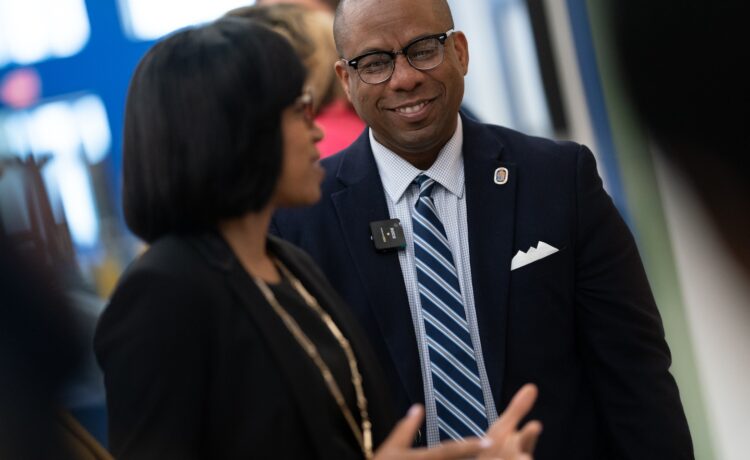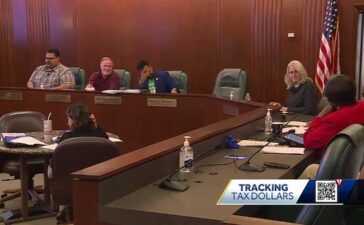The decision comes after weeks of conversations among county leaders over whether to expand how Prince George’s uses money from local telecommunications and energy taxes to pay for schools. The taxes currently can be spent on school operating expenditures and other categories such as instructional salaries and special education.
Alsobrooks asked state lawmakers for more flexibility to help cover rising costs fueled by the Blueprint for Maryland’s Future, a law that calls for increased spending for schools from the state and counties, and to help the county close a $171 million deficit.
Alsobrooks sent a letter to the county’s House delegation Thursday warning of the consequences of not passing both bills, saying it could require additional cuts to services. She also said the delays in voting on the bills have placed county officials in “jeopardy” of not meeting their legally mandated March 15 deadline to submit a budget to the county council.
The county spent about 60 percent of its budget on schools in fiscal 2020. That grew to 62 percent for the current budget year to comply with Blueprint guidelines. An additional 20 percent goes to fund public safety, leaving 18 percent of the budget for other county initiatives, she said.
“That 18 [percent] provides for our seniors, our roads and highways, our trash and litter pickup, our health and human services, our environmental goals and storm water management, our small and minority businesses,” Alsobrooks told the delegation. “The only way that we can fully fund our Blueprint obligation while also maintaining core services that our residents expect and deserve is to pass this legislation.”
The Prince George’s school board has opposed amending the taxes, and school officials have said that adjusting the earmarks could require service cuts since they prepared budget proposals assuming the revenue would be allocated the way it had been in the past.
State lawmakers said they had pressed the district to provide more details on possible cuts, to no avail.
During Friday’s county House delegation meeting, Del. Joseline A. Peña-Melnyk (D-District 21) expressed exasperation that her multiple requests for information about what the school system would need to cut were met with no response.
“It’s like I’m blind. I don’t know what I’m voting for because I never got that list,” she said. “I have a really hard time understanding why our county executive can’t sit with the superintendent she recommended and come up with some type of compromise.”
On Friday, Prince George’s School Board Chair Judy Mickens-Murray said in an interview that “board leadership understands the budget constraints facing the county.” She said she was uncertain where any cuts would come from, since the school board typically reconciles the budget in June.
“We leave it to the [House delegation] to make the best decisions they can to ensure that our children receive what they need for education and to also address the needs of the community,” Mickens-Murray (At-Large) said.
In a statement to The Washington Post, Prince George’s schools spokeswoman Meghan Thornton said the system is committed to reducing any adverse effects as it assesses its 2024-25 budget. “PGCPS is dedicated to collaborating with all stakeholders, including the Board of Education and the County Executive’s office, to navigate these challenges effectively,” she said.
A fiscal note stated that the proposal to adjust the use of the sales and use tax on energy and fuel could decrease county expenditures for the school system by $53.2 million in fiscal 2025 and by $64.7 million in 2029.
A similar note about the telecommunications tax said county expenditures for the school system may decrease by $13.1 million in fiscal 2025 and by $16 million in 2029.
In Alsobrooks’s letter to the delegation, she noted that the bills would result in “a smaller increase than [the school district] expected.” But she wrote that the schools are also receiving $53 million more in state and local funding compared with the previous year.
“This year alone our school system will receive $90 million in additional Blueprint dollars in [fiscal 2025], with $60 million from the state and $30 million from the county,” she wrote. She said the district isn’t being forced to cut anything paid for in this year’s budget.
Alsobrooks said the county has already identified $100 million in reductions, including freezing 450 positions in the county, defunding more than 800 other county roles and delaying capital projects.
The concerns raised by Prince George’s about the Blueprint law and its hefty price tag echo those in other areas. The law is projected to funnel billions into public schools to boost teacher salaries, funding for special education and other resources. But some county executives say the Blueprint’s requirements are straining their resources.
Last November, government leaders from Maryland’s 24 jurisdictions sent a letter to Gov. Wes Moore (D) and legislative leaders arguing that many school systems in the state had recently received record levels of county funding, and further increases mandated by the Blueprint “will limit counties’ ability to fund competing governmental needs at basic operational levels.”
A 2022 state report showed that Prince George’s was expected to increase its spending on schools significantly to comply with the Blueprint plan. Prince George’s was identified as one of four jurisdictions that would need to increase its funding to the school system by at least 5 percent in fiscal 2023 to meet the Blueprint mandates, or about $44 million, according to the local fiscal impact report released by the Maryland Department of Legislative Services.
Some county executives have gone to the General Assembly to advocate for changes to the state tax codes as a way to foot the Blueprint’s bill.
Recently, Montgomery County Executive Marc Elrich (D) spoke in favor of a bill that would raise the income tax rate for high-income earners. Currently, Maryland law caps the income tax rate at 3.2 percent, and 13 jurisdictions — including Prince George’s County — have reached that threshold. The bill stipulates that the revenue would go toward education and transportation needs.
Among the Prince George’s House delegation, the county’s request to update the local tax bills faced some opposition.
Del. Ashanti F. Martinez (D-District 22), a Parkdale High School graduate who voted against the bills Friday, spoke in an interview about his education growing up in the county, where the most vulnerable, such as students who speak English as a second language, are often the first to have their services axed when cuts are imminent.
“I believe every single one of us cares about Prince George’s County,” Martinez said. “I wish we had more deliberation and discussion about this very big decision that we made.”
Del. Andrea Fletcher Harrison (D-District 24) told her colleagues in Friday’s meeting that their task was not easy but that she was supporting the bills because she understands “what it is to have to try to fill gaps.”
“I was on the county council when the world crashed basically, and our employees of the Prince George’s County were furloughed,” she said. “They had children in public schools. They were not getting checks … but the school system got money.”
The bills must be approved by the full House before reaching the state Senate. If the Senate approves, the bills could become law as soon as July 1.

















